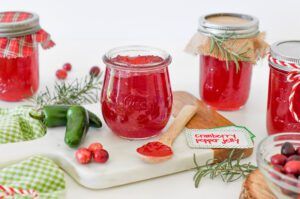
Sage advice: Holiday cooking with herbs
For Sarah Liberta, owner of HERBS by Sarah, the right herb can make all the difference in a holiday dish. Fresh herbs, she says, can be used with near limitless variety, from generous servings to spare sprinklings, and in several combinations. Dried herbs, too, can add a burst of concentrated flavor to please any palate. To learn a few tricks for spicing up your holiday feasts, check out Liberta’s tips below:
Signs of the thymes
These tiny leaves pack a lot of mildly resinous flavor. With hundreds of varieties in undertones of lemon, lime, orange, balsam, caraway and more, a well-stocked nursery can provide enough selections for a garden collection focused entirely on thyme. Since it releases its oils slowly, thyme is excellent in soups, stews and all manner of braised dishes. It’s also delicious for compound butter, eggs, meat, fish, vegetables and dressings.
Minty fresh
Mint is the coolest of herbs, with a bright, refreshing flavor, and works as an excellent digestive. Its hundreds of varieties derive from two types: spearmint and peppermint. Spearmints are sweet; peppermints, spicy. My favorite, red-stemmed apple mint, is the only variety containing the oils of both types. Use it in drinks like teas and cocktails, or in jellies, salads and desserts. It pairs especially well with chocolate.
Savory sage
An essential herb for Thanksgiving dressings, stuffings and breakfast sausages, sage has an earthy, pungent flavor that makes it perfect for poultry, veal and the flavorful root vegetables of fall and winter. Italians especially love to fry fresh sage leaves for a flavor that jumps in the mouth, as in Saltimbocca alla Romana, a veal dish.
Dill with it
With a crisp, distinct flavor, dill is a cousin of parsley, carrots, celery, fennel, anise and other hollow-stemmed members of the Umbelliferae family. It is excellent with fish, eggs, potatoes, cucumbers and other veggies, and it’s best used fresh, rather than cooked. For a delicious sauce or spread, stir chopped dill weed into yogurt, sour cream or whipped butter. It will likely work well in your favorite vinaigrette or seafood marinade, too.
Roasting with rosemary
This is often called the herb of Christmas, believed to be one of the manger herbs. It is highly aromatic, resinous and pungent, so use it sparingly! I like to use it with poultry, lamb, beef and pork, and it’s also delicious in focaccia bread, cookies and cakes, with just a touch—finely chopped—in the batter. If you tie a few fresh sprigs into a bundle and dip it in oil or basting sauce, you can even use it as a brush on the grill.











